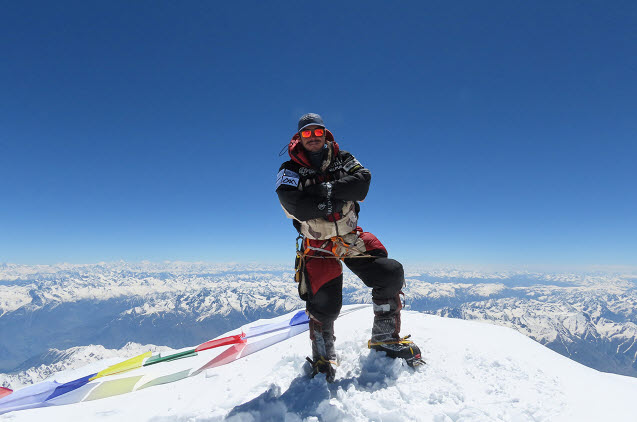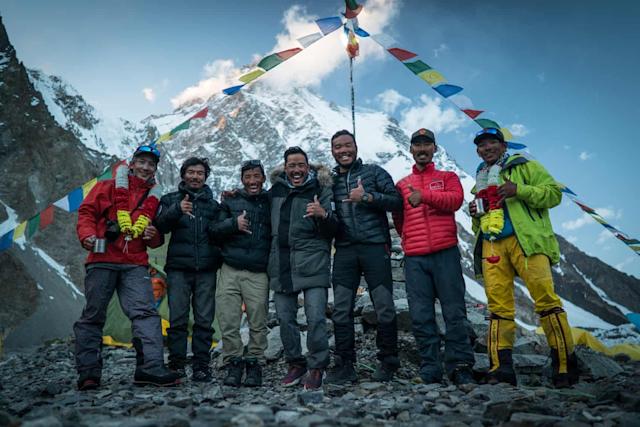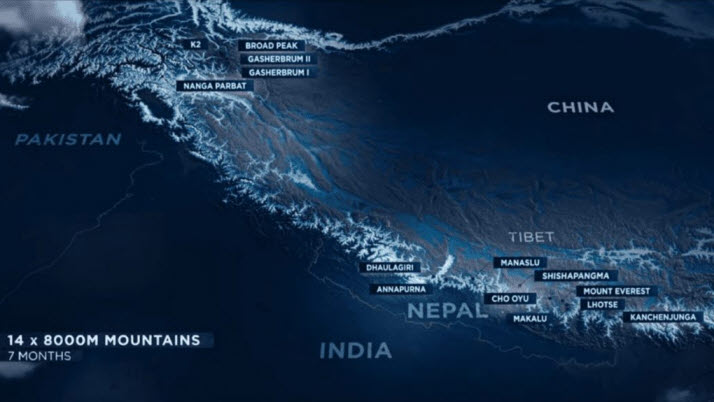Netflix documentary “14 Peaks: Nothing Is Impossible”, which was released on this Monday, is about one extraordinary achievement which certainly deserves to be known more to us. As reflected by the very title of the documentary, the hero of the documentary and his team succeeded in climbing all 14 eight-thousander peaks of the Himalayas within less than a year, and the documentary gives us a close look into their ambitious project which was surely quite risky and demanding from the beginning.
At first, we are introduced to a Nepalese dude named Nirmal Purja, and the documentary alternates between his life story and the gradual progress of his project. As the youngest son of a poor family in Kathmandu, Nepal, Purja has always been drawn to challenging tasks to prove himself more since he was young, and that was one of the main reasons why he decided to climb all those 14 summits of the Himalayas within several months in 2019 even though nobody had ever tried to do that within such a short period before. Since renowned Italian Mountaineer Reinhold Messner succeeded in climbing all the 14 summits during 1970-1986, a number of other mountaineers also accomplished the same thing, but it took more than 5 years even in the case of the shortest record time in the bunch.
Nevertheless, Purja was not daunted at all as he has been quite accustomed to physically arduous tasks throughout his whole life. After all, before he decided to pursue a mountaineering career, he was in the Brigade of Gurkhas of the British Army and then subsequently joined the Special Boat Service (SBS), the special forces unit of the Royal Navy. Once he successfully went through all those difficult military trainings, he was later put into real combats, and he tells us about one scary incident where he avoided death thanks to sheer luck.
Although his old parents had depended a lot on the money from his military career, Purja decided to quit the army in 2018 because of his growing passion toward mountaineering, and he promptly embarked on gathering enough fund for his project, but, understandably, nobody was interested in funding “Project Possible” because it felt too impossible to say the least. Nevertheless, Purja did not give up at all, and, with the agreement from his ever-understanding wife, he eventually got the fund via re-mortgaging their house.
Besides testing on whether he was physically fit enough to accomplish the aim of Project Possible, Purja also assembled the team. His team members were all his fellow Nepalese mountaineers, and that meant a lot to all of them because their success would bring more attention to not only their country but also many overlooked Nepalese mountaineers who were substantial in those numerous Himalayan climbings since Edmund Hilary climbed on Everest with Tenzing Norgay in 1953.
Purja’s plan consisted of three phases. First, he and his colleagues were going to climb on the six summits in Nepal including Everest, and then they would move onto the five other summits in Pakistan, and then they would go for the last three summits in Tibet, China. Their first summit to climb was Annapurna, and they were reminded again of how risky it is to climb this infamous summit. When they climbed down shortly after reaching to the summit at last, they came across a mountaineer who was in a very serious medical condition, and the mood becomes tense as we see them and others subsequently trying to bring back this unfortunate mountaineer to the base camp and then send this person to a big hospital in Kathmandu as soon as possible.
As they accomplished the task of the phase one and then moved onto the phase two, Purja and his colleagues became more confident than before, though there were still unexpected obstacles here and there around them. In case of K2, another notorious summit in the Himalayas, they took much more risk for climbing that summit than expected, but they eventually succeeded, and that incidentally also happened to help other teams a lot. Around the time when they embarked on the phase three, the Chinese government happened to stand on their way, but they kept trying to persuade the Chinese government in one way or another, and the Chinese government finally allowed them to climb all of the three summits in Tibet.
And there was also a serious personal matter involved with Purja’s mother, who was not that well even before her son embarked on Project Possible. At one point, it seemed quite possible that Purja should abort his project for spending more time with her, but, despite her increasingly fragile physical condition, she told him to keep going as usual, and she did live long enough to see the eventual end of her son’s project.
The documentary comes to lose some of its narrative momentum as reaching to its expected arrival point, but it keeps holding our attention nonetheless under the competent direction of director/co-writer/co-producer Torquil Jones. Besides those obligatory shots showing us how huge and challenging those 14 summits look under the bright and clear blue sky, there are also lots of vivid and frightening moments captured during the climbings of Purja and his colleagues, and I must say I was often marveled by how they managed to record all these moments even though they also had to focus a lot on other things besides their safety during that time.
On the whole, “14 Peaks: Nothing Is Possible” is an engaging documentary which is often awe-inspiring and thrilling for a number of impressive moments to remember, and it also reminds me again of my longtime aversion to high places. Sure, I want to watch those summits of the Himalayas for myself someday, but, folks, please don’t ever force me to climb on them.










